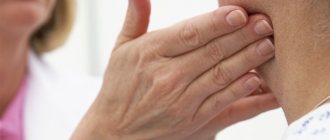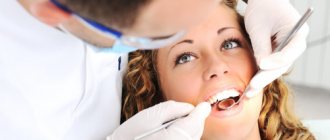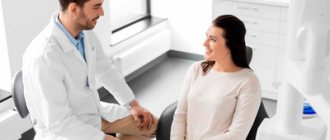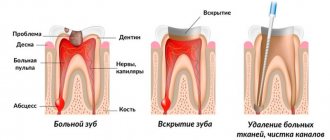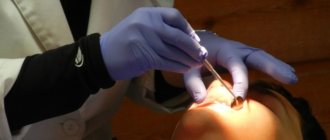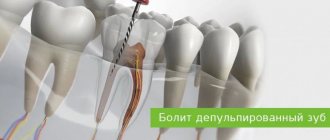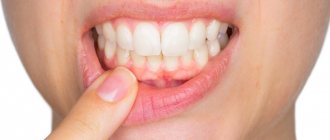Jaw pain in the ear area usually indicates ear and dental pathologies. However, in practice it turns out that severe pain syndrome is caused by joint, heart and tumor diseases. Discomfort in the jaw area may also indicate the progression of a benign or malignant tumor. Therefore, if persistent pain is detected, it is necessary to urgently consult a doctor.
What problems can cause such pain?
Most often, discomfort in the jaw space near the ear develops against the background of dental, bone, joint and heart problems.
Features of pathologies are presented in the table:
| Cause of pain | Description |
| Bone problems | General information: When bone tissue is damaged, the pain radiates to the ear area. Most often this happens with head injuries, fractures of the facial bones of the skull and injuries to the jaw. Symptoms: In case of fractures or damage to bone tissue, the patient detects hematomas at the site of impact, feels pain when chewing or opening the mouth, and observes the appearance of swelling in the fracture area. In more advanced cases, bone displacement develops, which leads to severe pain in the jaw and ear. |
| With joints | General information: Diseases of the temporomandibular joint are often accompanied by aching pain that radiates to the ear area. As the inflammatory process progresses, it becomes difficult for the patient to open his mouth and chew food. Often, the pain syndrome develops against the background of arthrosis, arthritis, which manifests itself in the form of stiffness in mouth movements and aching pain. Symptoms: With articular pathologies, the patient experiences discomfort when opening the mouth, a characteristic clicking sound in the jaw when trying to chew food, and a change in the nature of the pain during the day: it can be aching, pressing, pulsating. When pressing on the problem area, the pain usually intensifies. |
| Problem with the heart and blood vessels | General information: If discomfort in the jaw area is accompanied by pain in the left side of the chest, then the cause of the problem may be cardiovascular disease. As angina progresses, pain radiates to different organs. Most often, discomfort is felt in the arm and shoulder area, but often heart pain radiates to the left jaw and ear. Symptoms: Cardiac pathologies are accompanied by the appearance of sharp pain in the heart, as well as discomfort in the arm, jaw, and temporal zone. As the disease progresses, the pain intensity increases. In this case, the patient needs immediate medical attention. |
| Tumors | General information: With the development of tumor pathologies, in addition to discomfort, the patient may find a lump in the jaw area or behind the ear. The tumor either hurts when pressed or does not produce significant symptoms. It all depends on the nature of the tumor. Symptoms: With the development of tumor diseases, the patient may notice a lump on the jaw or near the ear, which hurts when touched, swells, and interferes with chewing food and opening the mouth. In addition, the patient may observe an increase in the nearest lymph nodes if we are talking about a malignant disease. If a lump is detected, you should not hesitate to seek medical help or self-medicate, as this can lead to disastrous consequences. |
| Dental problems | General information: Dental pathologies are one of the most common causes of pain in the jaw and ear. Discomfort occurs against the background of untreated caries, pulpitis, and growth of wisdom teeth. Symptoms: With dental pathologies, the patient feels pain not only from the outer part of the jaw, but also from the inside. It is painful for the patient to chew food, open his mouth, or drink hot or cold drinks. In some diseases, for example, pulpitis, the pain spreads to the entire facial part, on the side of which the diseased tooth is located. |
Doctor about the causes of jaw pain:
Foreign body
Getting a foreign object into the ear is not uncommon. Moreover, not only children suffer from this when they place beads, peas, small parts of toys into the ear canal, but also adults when they carelessly clean their ears with sharp objects (matches, toothpicks, etc.) or test the advice of traditional medicine on themselves by sticking gauze inside , cotton wool and even food. Insects or small objects can get into the ear canal due to injuries or accidents. If you suspect that a foreign object has entered the hearing organ, you should not try to cope with the problem yourself: this can lead to damage to the ear canal. With inept movements, you can push the object even further into the depths, thereby greatly aggravating the situation. Help from a doctor for pain caused by a foreign body is the only sure way out!
Why does my jaw hurt near my ear?
Pain in the jaw area is a serious symptom that signals the progression of various pathologies. These can be dental diseases, ENT diseases, viral infections, oncological processes in the body. Only a doctor can determine the cause of discomfort after a comprehensive diagnosis.
Dental diseases
Dental diseases are one of the main reasons influencing the development of jaw pain.
Common pathologies that cause pain:
- osteomyelitis . A purulent infectious disease that affects most of the structural components of the jaw bone. The pathology is accompanied by aching pain in the chin area, weakness, chills, and increased body temperature. As the disease progresses, it is difficult for the patient to open his mouth, chew food, or talk. In more advanced cases, the patient's lower face swells, fistulas form, or an abscess develops. Pathology is eliminated with the help of antimicrobial and anti-inflammatory drugs;
- gingivitis . This is an inflammatory disease of the gums that appears against the background of a violation of the integrity of the dentogingival attachment. Gingivitis most often affects teenagers or pregnant women. The development of the disease is influenced by many factors: improper oral care, bad habits, reduced immunity, dental pathologies, caries, infections. The main symptoms of the pathology include pain in the jaw area, radiating to the ear, swelling and redness of the jaw, pain in the teeth, which intensifies when eating cold, hot and spicy foods. In advanced cases, the gums begin to bleed. Gingivitis is treated with antibiotics, anti-inflammatory drugs, and immunostimulating medicinal products;
- alveolitis . a disease accompanied by acute and aching pain in the tooth socket, which most often develops after tooth extraction or surgical treatment. Pain in the gums itself after surgery is considered normal, but if it does not subside a week after the procedure, we may be talking about the formation of alveolitis. As the disease progresses, the patient experiences pain in the tooth socket, which increases in intensity upon contact with food. Discomfort is added by periodic bleeding of the gums, pain in the jaw, ear, and temple areas. The pain syndrome varies in nature: from acute to mild. Treatment occurs with the help of anti-inflammatory and analgesic agents;
- abscess . An abscess develops due to various reasons: injury, infections, viruses, untreated dental pathologies. Accompanied by the appearance of severe headaches that radiate to the jaw, ear, and temples. The patient's temperature rises, general signs of chills appear, and a swelling forms in the gum area, under which there is pus. The tumor hurts when pressed. To treat an abscess, surgical methods combined with drug therapy are used. Initially, the doctor removes the tumor, cleans the wound, and then prescribes antibiotics and immunostimulating drugs to the patient.
Osteomyelitis
Gingivitis
Alveolitis
Abscess
Often, pain in the jaw appears due to an incorrect bite or untreated caries. In such cases, the pain syndrome is unexpressed and may disappear and reappear. Discomfort is easily relieved with analgesics.
Important! The patient must remember that if the problem is ignored for a long time, there is a risk of developing complications with more serious and intense symptoms.
ENT diseases
Discomfort in the jaw area can develop against the background of ENT pathologies :
- glossitis . Glossitis is an inflammation of the tongue tissues, which indicates the development of viral infections. The pathology is accompanied by pain in the tongue area, spreading to the gums and jaw, a burning sensation when food gets in, the development of swelling of the tongue, increased salivation, and speech dysfunction. To treat the disease, antibacterial, antifungal, anti-inflammatory drugs, as well as immunostimulating agents are used;
- pharyngitis . Pharyngitis is an inflammatory disease that occurs against the background of damage to the mucous membrane of the throat and lymphoid tissue. The disease develops when viruses, infections, and fungi enter the body. Pharyngitis is accompanied by pain and dryness in the throat, inflammation of the cervical and ear lymph nodes, pain in the chin, cheekbone, ear area, fever and chills. The disease is treated with anti-inflammatory drugs, antibiotics, antiviral drugs;
- erythroothalgia . Erythroothalgia is a clinical syndrome that is accompanied by acute pain in the ear cavity, radiating to the chin, jaw, and back of the head. The pathology often entails an increase in body temperature and discomfort when opening the mouth and chewing food. To eliminate the disease, complex therapy is used, which is selected individually.
Glossitis
Pharyngitis
Erythroothalgia
Pain syndrome in the jaw area near the ear can also appear against the background of chronic tonsillitis, acute rhinitis, sinusitis, and diffuse otitis media. If such diseases develop, the patient will need medical attention.
Other diseases
Jaw pain can occur due to the following diseases:
- carotidynia . This is a type of migraine accompanied by acute headache and discomfort in the lower part of the face. If left untreated for a long time, the pain syndrome spreads to the entire facial area;
- inflammatory process in ARVI . Pain syndrome during ARVI signals inflammation of the ternary nerve. In this case, the infection penetrates the nerve and blood vessels, as a result of which the patient’s entire face begins to hurt. The patient observes pressing pain in the jaw, temples, and frontal area. Inflammation of the ternary nerve is treated with antibiotics, anti-inflammatory drugs, painkillers;
- TMJ dysfunction . Dysfunction of the temporomandibular joint is accompanied by pain in the jaw and ear when swallowing food or opening the mouth. Patients may observe the appearance of crunches and clicks that appear at the slightest movement of the jaw. Often, TMJ dysfunction is accompanied by congestion and tinnitus, hearing impairment;
- oncology . Jaw cancer develops against the background of frequent injuries to the maxillofacial area, lack of timely treatment of dental pathologies, smoking and drug abuse. The pathology is accompanied by the development of weakness in the body, sudden weight loss, headache and jaw pain, and the appearance of lumps in the problem area.
Discomfort in the jaw area under the ear can signal the development of neuralgic pathologies: inflammation of the superior laryngeal or glossopharyngeal nerve. In this case, the pain is acute. Often, pain in the jaw area indicates cervical osteochondrosis, scoliosis, and vegetative-vascular dystonia.
Causes not related to diseases
Discomfort in the jaw often develops due to bruises, fractures and dislocations, which patients can receive in accidents, fights, or falls.
With minor injuries, swelling in the problem area, mild pain, and the appearance of bruises and hematomas are observed. The patient experiences malaise, headache, dizziness and drowsiness. With fractures, the patient develops the following symptoms :
- acute pain that is not relieved by analyzing means;
- nausea, headache, dizziness;
- problems opening the mouth and chewing;
- speech dysfunction;
- facial asymmetry;
- the appearance of bruises;
- drooping eyeballs.
A fracture is dangerous because it can cause breathing problems and contribute to tongue retraction.
Attention! In case of a jaw fracture, you must immediately call an ambulance. Self-medication can lead to disastrous consequences. In 10% of cases, jaw fractures are fatal.
Sulfur plugs
Earwax is an accumulation of earwax in the ear, which subsequently hardens and causes discomfort, tinnitus appears, and hearing loss decreases. In a healthy person, excess sulfur is removed spontaneously, for example, when chewing. But in some people, wax cannot be removed on its own; it accumulates near the ear canal, hardens and forms a plug. There is no need to try to get rid of the cork on your own, much less try to remove it with sharp objects (matches, toothpicks, etc.) - damage to the tissues of the shell or eardrum cannot be avoided in this case. The plug is removed by an ENT doctor. The procedure does not take much time: first he softens the plug with oil or solutions, and then rinses it with a special syringe or removes the sulfur plug with a special Wojacek hook.
Associated symptoms and what they indicate
You can determine the cause of the pain syndrome if you carefully study its nature. The pain can be acute, throbbing, pressing, mild, and appears only when chewing or pressing. Each of them indicates the presence of different diseases in the body.
Different localization of pain
If pain appears in different places and does not have a clear localization, this may indicate dental and neurological pathologies.
For example, with pulpitis, half of the facial part is affected, on the side of which the diseased tooth is located. In this case, the patient is tormented by shooting pains that manifest themselves in the jaw, temple, cheekbone, and chin. The same is observed with inflammation of the ternary nerve. In this case, the patient also observes a shift in pain from the jaw area to the temporal, zygomatic, and frontal.
Different character
You can determine the cause of discomfort by the nature of the pain :
- spicy _ Sharp and acute pain most often develops against the background of an open or closed fracture, neuralgic inflammation, pulpitis, osteomyelitis;
- pulsating _ Pulsating sensations can develop against the background of caries, periodontitis, cysts, gingivitis, angina pectoris, otitis media;
- aching _ Such sensations signal malocclusion, infectious pathologies, growth of wisdom teeth, neuralgic diseases, dislocations;
Pain in the ear that extends to the jaw and back in some cases indicates the development of infectious diseases, diseases of the jaw and temporal joint, otitis media, tumor neoplasms, and dental pathologies.
Pain occurs when chewing
Pain in the jaw area sometimes does not bother a person at rest, but makes itself felt when chewing food.
Most often, such symptoms indicate the following pathologies :
- bruises, dislocations, closed fractures due to accidents, injuries, falls;
- dental diseases: pulpitis, periodontitis, alveolitis;
- growth of wisdom teeth;
- purulent diseases: osteomyelitis, boil, abscess;
- tumor neoplasms: osteoma, adamantioma;
- carotidynia, inflammation of the ternary nerve.
Reference! Pain in the jaw area, radiating to the ear, often occurs after wearing braces or undergoing surgical treatment.
Pain when pressed
If intense pain in the jaw and chin develops with pressure, this may indicate the following pathologies :
- wisdom tooth growth;
- injury to the jaw area: dislocation, bruise;
- inflammation of the lymph nodes due to viral infections;
- purulent processes: abscess, osteomyelitis, phlegmon;
- pathologies of the temporomandibular joint due to arthritis, arthrosis;
- bite problems;
- benign and malignant neoplasms;
- neuralgic diseases.
Often pain when pressing occurs against the background of angina or heart attack.
Unilateral/bilateral pain on the right/left
Unilateral pain on the right or left side of the face can signal dental and neuralgic diseases. Discomfort on the right or left often occurs due to a diseased tooth located in these parts. Similar symptoms are observed with pulpitis, periodontitis, caries.
Also, one-sided discomfort can indicate heart disease or the growth of wisdom teeth, inflammation of the ternary nerve. Bilateral pain is typical for bruises, dislocations, and malocclusion.
Jaw cracked
Pain syndrome, which is accompanied by a crunching sound, can signal the progression of the following pathologies :
- arthritis, arthrosis;
- TMJ dysfunction;
- wear of tooth enamel;
- injuries;
- malocclusion;
- neurotic spasms.
A painful jaw crunch occurs when the ligaments are sprained.
The jaw/cheekbone is swollen
Swelling may appear as a result of injury to the problem area.
Swelling often develops after dental surgery. Similar symptoms are observed with purulent abscess, malignant or benign diseases, and enlarged cervical and ear lymph nodes.
A number of other pathologies in which the patient detects puffiness and swelling in the chin area:
- odontoma;
- cementoma;
- osteoma;
- odontogenic fibroma.
Swelling sometimes appears as wisdom teeth grow.
Doctor about jaw pain:
Ear diseases in adults
Painful sensations can occur due to direct pathologies of the ear. These include: otitis media, eustachitis, tumors.
Otitis is an infectious inflammation of the ear, the leader among diseases of the ENT organs in terms of the number of visits to an otolaryngologist. The causes of the disease are untreated infectious diseases of the upper respiratory tract (tonsillitis, pharyngitis, laryngitis, sinusitis), rhinitis, a deformed nasal septum, damage to the auricle, penetration of water into it or infections after self-cleaning the ear with foreign objects.
The human hearing organ consists of the outer, middle, and inner ear. Accordingly, external, middle and internal otitis are distinguished.
Otitis externa covers the ear canal. Basically, the disease develops when water penetrates into it while swimming. There is even the term “swimmer’s ear”: otitis media occurs with frequent contact with water. For treatment of ear pain caused by otitis externa, you should contact an otolaryngologist.
Friends! Timely and correct treatment will ensure you a speedy recovery!
Otitis media: a third of all visits to an otolaryngologist are associated with this type of otitis. The main complaint of patients is shooting pain in the middle ear. The disease can occur in several forms: acute, exudative and chronic purulent.
Internal otitis (labyrinthitis) is an inflammatory disease of the inner ear. The disease is severe and occurs infrequently: usually as a complication of otitis media or a severe form of another infectious disease (for example, tuberculosis).
If you suspect inflammation, you should not self-medicate: incorrectly prescribed treatment for otitis media or an undertreated condition can cause serious complications. Only an otolaryngologist can provide effective assistance to an adult with otitis media.
Eustachitis is an inflammation of the Eustachian (auditory) tube, which connects the organ of hearing to the nasopharynx. The Eustachian tube is needed to better capture sounds and ventilate the middle ear through the nasopharynx. With the qualified help of an otolaryngologist, treatment of ear pain caused by eustachitis occurs quickly, and relief occurs in a couple of days.
Ear tumors are uncommon. CT and MRI are used to determine pathology.
How to relieve the condition at home
In case of fractures or other injuries to the jaw area, the patient is advised to immediately apply a cold compress to the sore spot and not remove it until the doctor arrives.
If dental pathologies cause discomfort, you need to take a painkiller and rinse your mouth with warm soda solution. It is not recommended to take a horizontal position during throbbing and nagging pain, as the discomfort will intensify.
If the pain appears as a result of viral infections and inflammation of the lymph nodes, you need to gargle with a solution of furatsilin or soda with salt, drink an anti-inflammatory antipyretic drug and wait for the ambulance to arrive.
Diagnosis and treatment of ear pain in Moscow
At the appointment, the doctor talks with the patient, collects anamnesis and conducts an examination using an otoscope, assesses the condition of the outer ear, ear canal and eardrum. He examines the pharynx, larynx, oral cavity and nasal passages. Sometimes the patient is referred for audiometry. If the cause of the pain is injury, you will also need to do an X-ray or CT scan.
Ear treatment in Moscow is offered by many medical institutions: from district clinics to multidisciplinary medical centers. The final cost of ear treatment in Moscow depends on the type of medical institution and its pricing policy. "ENT Clinic of Doctor Zaitsev" specializes in diseases of the hearing organs. Treatment of ear diseases is our specialty. We use the most modern equipment from famous world manufacturers. Our doctors' many years of experience allow us to successfully diagnose hearing pathologies and offer the most effective treatment. Prices for our services have not changed for more than three years.
If ear pain and other unpleasant symptoms appear, do not tolerate it and do not self-medicate. Please call, make an appointment and come. We will be happy to help you!
Which doctors should I contact?
The choice of doctor for discomfort in the jaw area depends on the pathology that led to such symptoms.
If you have jaw pain, you can go to the following specialists:
- therapist (will examine the patient and give a referral to the right doctor);
- traumatologist;
- dentist;
- ENT;
- infectious disease specialist;
- cardiologist;
- neurologist;
- oncologist.
Advice! In case of acute abscesses and other purulent pathologies, it is advisable to immediately contact a surgeon.
Ear pain in a healthy person
Unpleasant sensations in the organ of hearing can occur in a completely healthy person, and there are many reasons for this (we will look at some in more detail):
- sensitivity to strong wind and cold (Due to a long stay in the wind, a hematoma may form in the ear - it will go away on its own in a few days. No additional measures need to be taken in this situation.);
- water getting into the ear;
- presence of sulfur plug;
- mechanical injuries (if, in addition to pain, bleeding from the ear begins, consult a doctor immediately);
- acoustic injuries (occur due to exposure to loud sounds on the organ of hearing, for example, at a rock concert, in a noisy industry, or during prolonged use of headphones. As a rule, the pain goes away when moving away from the source of noise. If, due to the nature of the work, it is impossible to eliminate the source of noise, You definitely need to use special earplugs.);
- barotrauma (manifested by changes in atmospheric pressure; most often occur during air travel or diving. When your ears are blocked on an airplane, you need to yawn more often, swallow, or simply chew something to eliminate the condition of “stuffiness”);
- foreign body.
What kind of diagnostics awaits?
Diagnostic methods are prescribed by the doctor after a thorough examination of the patient and studying his medical history. To make a diagnosis, the following research methods :
- laboratory tests to determine the presence of infections, viruses and other pathogenic microorganisms;
- radiography;
- CT scan;
- Magnetic resonance imaging;
- arthrography;
- electromyography.
If the doctor suspects the development of a malignant tumor, the patient will be prescribed blood tests for tumor markers. If there are lumps and ulcers, a cytological examination is performed (piercing the lump and collecting a fragment of internal secretion). If the patient has enlarged lymph nodes, a biopsy is performed.
Otitis externa
Most often, inflammation of the outer ear is bacterial in nature.
The causes of infection may be:
- trauma to the external auditory canal, for example, from a sharp or blunt object, or from a hearing aid;
- skin defects due to eczema, psoriasis, diabetes and other diseases;
- too thorough removal of earwax, which creates an acidic environment that prevents the growth of microbes;
- frequent entry of water into the outer ear (“swimmer’s disease”).
Symptoms of external otitis:
- acute ear pain, aggravated by pressing on the tragus or pulling the earlobe;
- possible itching and a feeling of “stuffiness” in the ear;
- discharge of a purulent or bloody nature, sometimes having an unpleasant odor;
- examination reveals swelling and hyperemia of the external auditory canal;
- possible hearing loss;
- enlargement and tenderness of the lymph nodes in the neck and behind the ear on the affected side.
The course of the disease may be complicated by a perforation of the eardrum, which cannot be determined without a visit to an ENT specialist.
External otitis of fungal origin is a common phenomenon, usually occurring in patients with low immune status or due to long-term use of antibacterial drops. It is characterized by severe itching, the formation of crusts, profuse thick discharge and the absence of a therapeutic effect from the use of antibiotics.
Separately, it is worth noting the localization of a boil on the skin of the external auditory canal or inflammation of the atheroma. The clinical picture is similar to otitis externa, but upon examination there is a more localized focus of inflammation with an opening from which pus and blood can be discharged.
What to do if your child’s jaw hurts
Pain in the jaw area in a child can also signal pathologies such as dislocations, bruises, pulpitis, caries, and pharyngitis. It is forbidden to independently engage in diagnostics if a pain syndrome is detected in a child.
Parents should immediately contact a therapist or pediatric dentist, surgeon, or neurologist. If dental problems are detected, children are prescribed medication. In more advanced cases, surgical therapy is used.
For serious injuries, physiotherapeutic procedures or surgical treatment are prescribed. For ENT pathologies, antibiotics, anti-inflammatory medicinal products, and immunostimulating drugs are used. To relieve pain before seeing a doctor, you can give your child half a painkiller tablet. For bruises, apply a cold compress to the problem area.
Ear pain - what to do?
As we can see, pain syndrome has a different nature of occurrence. Only a doctor can understand the real cause, establish the correct diagnosis and offer an effective treatment for ear pain in adults. An otolaryngologist treats ear diseases in adults. If you encounter such a problem, immediately contact a specialist.
Unfortunately, it is not always possible to visit a doctor right away. More often, unpleasant symptoms appear suddenly and at night. First of all, you need to take a pain reliever - an ibuprofen-based painkiller. It has anti-inflammatory properties and is most effective compared to other drugs.
If pain is accompanied by a runny nose, it would be a good idea to use vasoconstrictor nasal drops.
The first thing many patients do is run and buy ear drops for pain. But each drop has its own purpose: in one case they can fully treat, in another - not. Drops are not a universal remedy. Statistics show that when treating ears, in half of the cases patients mistakenly prescribe medications to themselves. Drops should be used only when you are completely confident in your diagnosis.
Drops will not help with injury - in such a situation it is better to take a painkiller and consult an ENT doctor. Heat compresses should not be used before consulting a doctor. For example, with purulent otitis, such a measure will only worsen the patient’s condition.
Before visiting a doctor, do not go out into the cold without a hat, do not try to clean the ear from secretions and pus in its depths on your own, and do not instill alcohol-based products.
As a rule, for ear infections of the middle ear, antibacterial agents are prescribed. For external inflammation - antibiotics in the form of drops. In any case, consultation with an ENT specialist is mandatory! Folk remedies can be used in combination with drug therapy and only after an accurate diagnosis, that is, after visiting a doctor.
Treatment methods, depending on the cause
Depending on the diagnosis made by the doctor, different methods of treating discomfort in the jaw area are used. This may include medication, surgery and herbal medicine.
Medication
For pain in the chin area, anti-inflammatory, analgesic, and antibiotic drugs are used. This method of therapy is effective for the following diseases :
- inflammatory diseases of the jaw joint;
- infectious pathologies;
- viral infections;
- dental diseases;
- articular and cardiac pathologies.
Important! Drug treatment is also advisable for problems with bones and ENT pathologies.
Surgical
Surgical methods of therapy are used in the following cases :
- malocclusion. Orthognathic surgeries are performed to remove facial asymmetry and change the bite;
- skeletal deformities of the jaw of the second, third class, developed against the background of injuries and dislocations;
- purulent abscess;
- dental pathologies requiring tooth extraction.
Surgical treatment is also prescribed in cases where medication has proven ineffective.
What types of operations are performed:
- removing the abscess and clearing the wound of pus;
- installation of a seal;
- installation of artificial dentures or crowns;
- surgery to restore bite;
- removal of teeth that cannot be treated with medication;
- removal of roots.
In oncology, excision of malignant neoplasms and metastases that have developed as the disease progresses is performed.
Physiotherapeutic
Physiotherapeutic procedures are used for pathologies of the temporomandibular joint, as well as after fractures, dislocations and bruises.
Such treatment methods relieve pain, reduce the manifestation of joint noise, swelling, and pulsation.
Physiotherapy for jaw diseases includes the following treatment methods :
- transcutaneous nerve stimulation to reduce pain;
- procedures using ultrasound to reduce myofascial pain);
- short-wave diathermy to reduce the intensity of pain and swelling;
- laser therapy to eliminate myogenic pain;
- manual therapy to alleviate negative symptoms in temporomandibular pathologies;
- home exercises to strengthen muscle and bone tissue.
Ultrasound and laser treatment methods are carried out within a medical institution. Manual therapy is used after a doctor’s prescription and is carried out in specialized offices or at home.
Folk
Traditional methods must be used in conjunction with medication and physiotherapeutic treatment.
Home therapy involves the use of anti-inflammatory compresses and herbal ointments, which reduce the intensity of pain, swelling and discomfort when swallowing.
How to make anti-inflammatory compresses :
- Mix one egg yolk with a teaspoon of turpentine, pour 1 spoon of apple cider vinegar into the mixture, mix all ingredients thoroughly. Treat the affected area with the resulting solution 3 times a day;
- Grate the black radish on a fine grater, strain the mixture through cheesecloth, add a spoonful of fresh honey, a glass of vodka and a spoonful of salt. Mix all ingredients. Apply the resulting solution to the affected area and leave for 15 minutes. Repeat the procedure 2 times a day.
Advice! In addition to compresses, the patient must remain in bed, exclude hard foods from the diet so as not to injure the jaw, and carry out simple exercises to develop the jaw joints.
Our doctors
Gogolev Vasily Gennadievich
Doctor - otorhinolaryngologist
20 years of experience
Make an appointment
Zharova Galina Gennadievna
Doctor - otorhinolaryngologist, member of the European Society of Rhinologists, doctor of the highest category
40 years of experience
Make an appointment
Debryansky Vladimir Alekseevich
Doctor - otorhinolaryngologist, doctor of the highest category
34 years of experience
Make an appointment
Supporting actions
Self-massage of the jaw area is necessary for developing muscles and joints. It is carried out using the following techniques :
- stroking;
- rubbing (with gentle pressure);
- effleurage
Before the procedure, the patient will need to thoroughly wash their hands and treat them with a small amount of oil, which will ensure good gliding of the hands over the skin. After this, you need to walk lightly over the problem area, spending no more than 5 minutes on each part of the body. The total duration of the massage should be within 15 minutes. You can massage the jaw area 2-3 times a day.
Gymnastics should be done only after a doctor’s prescription. It includes a series of strengthening and relaxing procedures that reduce pain and also allow the patient to get rid of crunching in the jaw area.
Examples of muscle relaxation exercises:
- the patient massages the chin area for 5 minutes, and then slowly pronounces all the letters of the alphabet, starting with the letter “B” and adding the sound “A” to each of them. The result is the syllables “Ba”, “Va”, “Ga”;
- the patient pronounces the letters of the alphabet, while simultaneously massaging the area of the chin and jaw;
- to strengthen the ligaments, the patient opens his mouth, stretches out his tongue to the fullest extent and tries to pull it towards the chin, in this position he lingers for 10 seconds. The exercises are repeated 15 times.
Therapeutic exercises can be performed 2-3 times a day. It is advisable that it goes away a few hours after eating. The duration of classes should not exceed 15 minutes. During the process, all movements must be smooth; strong jerks can lead to increased pain.
What to do if you have jaw pain:
Eustachite
Eustachitis is an inflammation of the canal connecting the middle ear to the nasopharynx. The degree of pain varies. Characteristic features are:
- feeling of stuffiness in the ear;
- noise and crackling in the ear, the patient hears his voice as too loud with a weakened perception of extraneous sounds;
- sensation of water pouring into the ear.
In the absence of timely treatment, eustachitis becomes chronic, causing chronic exudative otitis media.
Possible complications
If you do not promptly pay attention to the pain in the jaw area that extends to the ear, you may encounter unpleasant complications . Among them:
- partial or complete hearing loss;
- increased sensitivity of teeth, development of carious processes;
- muscle tension, which leads to pain in the back, shoulders, chest;
- dizziness, visual impairment, appearance of “spots” before the eyes;
- sleep disturbance, insomnia, and resulting depression;
- photophobia (fear of bright lighting);
- pain in the eyeball area;
- the appearance of tumor formations in the jaw area (during oncological processes);
- metastasis to vital organs.
In the initial stages of pathology development, the patient has a considerable chance of a full recovery. If you ignore the problem, the risk of encountering unpleasant consequences increases. In such cases, you will have to resort to surgery.
Pain in the jaw area is a serious symptom that signals the progression of many diseases. If discomfort is detected, the patient must take a painkiller tablet, apply a cold compress to the problem area (if damaged) and call a doctor. Such symptoms should not be ignored, as they can lead to problems with hearing or vision.
After recovery, you need to monitor the condition of your teeth, regularly visit the dentist, monitor your diet and the quality of food you eat, avoid stressful situations, and check every year for the presence of cancer processes in the body.
Inflammation of the inner ear (labyrinthitis)
The labyrinth is an organ of hearing and balance, is richly innervated and includes auditory and kinetic receptors, so its inflammation causes:
- severe ear pain and headaches;
- a sharp decrease in hearing, the appearance of noise, crackling, squeaking in the ear;
- dizziness, nausea, loss of orientation in space, horizontal nystagmus.
Labyrinthitis occurs as a result of the penetration of infection in various ways from different parts and cavities of the body:
- from the middle ear with untreated or advanced otitis media;
- with infected meninges during meningitis;
- with blood for diseases such as syphilis, tuberculosis, herpes;
- damage to the temporal region, the organ of hearing with disruption of the integrity of cells and blood vessels.
The disease requires immediate medical attention.
What causes bruises?
Jaw injury may result from:
- falls;
- blow;
- fights;
- children's games;
- accidents, etc.
The severity of the injury is determined taking into account the following factors:
- features of the surface or object that caused the injury;
- impact intensity;
- affected area of the face;
- condition of bone tissue before the incident.
The strength of the bruise and possible complications depend on the listed indicators. Regardless of the severity, it is important to see a doctor to evaluate the condition and prescribe appropriate treatment. This will avoid unforeseen consequences and quickly restore the damaged area.
Treatment for headaches behind the ear
The course of treatment includes various techniques that will eliminate the cause of the headache and all manifestations of the disease. A regimen can only be selected after examination and a final diagnosis; taking medications at home is not recommended. The following treatments may be needed:
- symptomatic drug therapy - includes painkillers and anti-inflammatory drugs, vitamins, remedies against cold and flu symptoms;
- antibacterial therapy - antibiotics are prescribed for bacterial diseases, as well as to prevent complications of viral infections;
- dental treatment – necessary for caries, diseases of teeth and gums;
- surgical intervention is prescribed to remove tumors in the ear canals, as well as when conservative treatment of mastoiditis is insufficiently effective.
At the Clinical Brain Institute, doctors will select the most effective treatment regimen. In most cases, taking medications as scheduled is sufficient, but additional procedures or surgery may also be required. The patient should listen to the opinion of specialists with many years of experience and strictly follow all recommendations.
Treatment
Treatment of inflammatory ear diseases includes:
- antibacterial, antiviral agents of local and general action;
- antipyretics, analgesics;
- physiotherapy;
- in some cases - surgical intervention.
Treatment must be based on accurate diagnosis, which is impossible outside a specialized clinic. The high professionalism of CELT specialists allows us to identify various diseases of the hearing organ and choose the most effective means of solving the problem.
Make an appointment through the application or by calling +7 +7 We work every day:
- Monday—Friday: 8.00—20.00
- Saturday: 8.00–18.00
- Sunday is a day off
The nearest metro and MCC stations to the clinic:
- Highway of Enthusiasts or Perovo
- Partisan
- Enthusiast Highway
Driving directions

